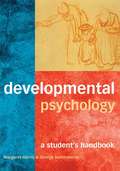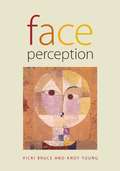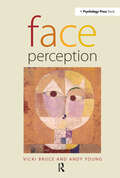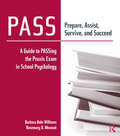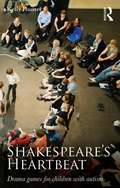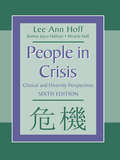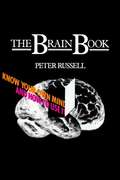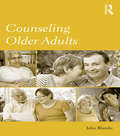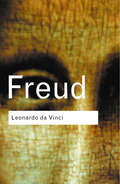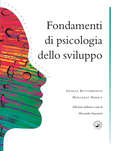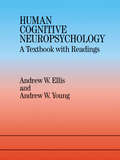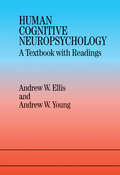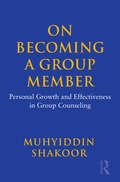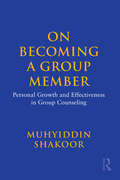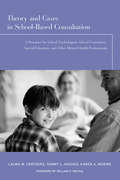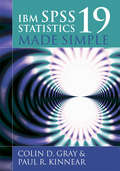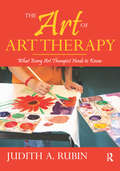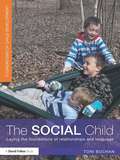- Table View
- List View
Developmental Psychology: A Student's Handbook
by Margaret Harris George ButterworthDevelopmental Psychology: A Student's Handbook is a major textbook that provides an up-to-date account of theory and research in the rapidly-changing field of child development. Margaret Harris and George Butterworth have produced an outstanding volume that includes recent research from Britain, Europe, and the USA.The text is designed for undergraduate students who have little or no prior knowledge of developmental psychology. Key features include: Specially designed textbook features, such as key term definitions, chapter summaries, and annotated further reading sections Over 95 figures and tables, to illustrate principles described in the text Additional boxed material, to add further insight and aid understanding Clear, user-friendly layout, to make topics easy to locate The book places developmental psychology in its historical context, tracing the emergence of the field as an independent discipline at the end of the 19th century, and following the radical changes that have occurred in our understanding of children's development since then. The development of the child is covered in sequence: through conception, pre-natal development, birth, infancy, and the pre-school years, to the achievements of the school years, and the changes that occur during adolescence. Each period is addressed in terms of cognitive, social, and linguistic development, including discussion of reading, spelling, and mathematical development. There is also consideration of comparative research concerning the development of cognitive abilities in other primates.Developmental Psychology: A Student's Handbook is essential reading for all undergraduate students of developmental psychology. It will also be of interest to those in education and healthcare studying child development.
Developmental Psychology: A Student's Handbook
by Margaret Harris George ButterworthDevelopmental Psychology: A Student's Handbook is a major textbook that provides an up-to-date account of theory and research in the rapidly-changing field of child development. Margaret Harris and George Butterworth have produced an outstanding volume that includes recent research from Britain, Europe, and the USA.The text is designed for undergraduate students who have little or no prior knowledge of developmental psychology. Key features include: Specially designed textbook features, such as key term definitions, chapter summaries, and annotated further reading sections Over 95 figures and tables, to illustrate principles described in the text Additional boxed material, to add further insight and aid understanding Clear, user-friendly layout, to make topics easy to locate The book places developmental psychology in its historical context, tracing the emergence of the field as an independent discipline at the end of the 19th century, and following the radical changes that have occurred in our understanding of children's development since then. The development of the child is covered in sequence: through conception, pre-natal development, birth, infancy, and the pre-school years, to the achievements of the school years, and the changes that occur during adolescence. Each period is addressed in terms of cognitive, social, and linguistic development, including discussion of reading, spelling, and mathematical development. There is also consideration of comparative research concerning the development of cognitive abilities in other primates.Developmental Psychology: A Student's Handbook is essential reading for all undergraduate students of developmental psychology. It will also be of interest to those in education and healthcare studying child development.
Face Perception
by Vicki Bruce Andy YoungHuman faces are unique biological structures that convey a complex variety of important social messages. Even strangers can tell things from our faces – our feelings, our locus of attention, something of what we are saying, our age, sex and ethnic group, whether they find us attractive. In recent years there has been genuine progress in understanding how our brains derive all these different messages from faces and what can happen when one or other of the structures involved is damaged. Face Perception provides an up-to-date, integrative summary by two authors who have helped develop and shape the field over the past 30 years. It encompasses topics as diverse as the visual information our brains can exploit when we look at faces, whether prejudicial attitudes can affect how we see faces, and how people with neurodevelopmental disorders see faces. The material is digested and summarised in a way that is accessible to students, within a structure that focuses on the different things we can do with faces. It offers a compelling synthesis of behavioural, neuropsychological and cognitive neuroscience approaches to develop a distinctive point of view of the area. The book concludes by reviewing what is known about the development of face processing and re-examines the question of what makes faces ‘special’. Written in a clear and accessible style, this is invaluable reading for all students and researchers interested in studying face perception and social cognition.
Face Perception
by Vicki Bruce Andy YoungHuman faces are unique biological structures that convey a complex variety of important social messages. Even strangers can tell things from our faces – our feelings, our locus of attention, something of what we are saying, our age, sex and ethnic group, whether they find us attractive. In recent years there has been genuine progress in understanding how our brains derive all these different messages from faces and what can happen when one or other of the structures involved is damaged. Face Perception provides an up-to-date, integrative summary by two authors who have helped develop and shape the field over the past 30 years. It encompasses topics as diverse as the visual information our brains can exploit when we look at faces, whether prejudicial attitudes can affect how we see faces, and how people with neurodevelopmental disorders see faces. The material is digested and summarised in a way that is accessible to students, within a structure that focuses on the different things we can do with faces. It offers a compelling synthesis of behavioural, neuropsychological and cognitive neuroscience approaches to develop a distinctive point of view of the area. The book concludes by reviewing what is known about the development of face processing and re-examines the question of what makes faces ‘special’. Written in a clear and accessible style, this is invaluable reading for all students and researchers interested in studying face perception and social cognition.
PASS: A Guide to PASSing the Praxis Exam in School Psychology
by Barbara Bole Williams Rosemary B. MennutiAre you getting ready to take the Praxis Exam and looking for a resource to help as you study? In this guide, Williams and Mennuti, two veteran school psychologists who have been involved in the development, testing, and revision of the Praxis Exam, present their PASS model to help you study and achieve the best score possible: Prepare – Find out how to register for the exam, what to bring with you on the day of the test, how the score reporting process works, and how to get ready to study. Chapters review each content area in-depth, and numerous graphic organizers provide invaluable study tools. Useful sample questions with rationales for correct and incorrect answers to each question are included at the end of each chapter to test your knowledge. Assist – Doing your best on the Praxis depends on successful study habits. The authors show you practical ways to review the material effectively and make the most of your time. Survive – Feeling overwhelmed? Learn how to get organized, develop a study schedule, take care of yourself, and manage your anxiety. Succeed – Show-up for the test prepared and confident, and walk-out knowing you did your best! In this guide, you’ll also find reflections from students who have used the PASS model to prepare for the Praxis, along with their experiences taking the exam and some of the challenges they faced and how they overcame them. An accompanying CD contains all of the graphic organizers found in the text, six practice exams with answer keys, and other helpful materials for you to use as you prepare for the exam.
PASS: A Guide to PASSing the Praxis Exam in School Psychology
by Barbara Bole Williams Rosemary B. MennutiAre you getting ready to take the Praxis Exam and looking for a resource to help as you study? In this guide, Williams and Mennuti, two veteran school psychologists who have been involved in the development, testing, and revision of the Praxis Exam, present their PASS model to help you study and achieve the best score possible: Prepare – Find out how to register for the exam, what to bring with you on the day of the test, how the score reporting process works, and how to get ready to study. Chapters review each content area in-depth, and numerous graphic organizers provide invaluable study tools. Useful sample questions with rationales for correct and incorrect answers to each question are included at the end of each chapter to test your knowledge. Assist – Doing your best on the Praxis depends on successful study habits. The authors show you practical ways to review the material effectively and make the most of your time. Survive – Feeling overwhelmed? Learn how to get organized, develop a study schedule, take care of yourself, and manage your anxiety. Succeed – Show-up for the test prepared and confident, and walk-out knowing you did your best! In this guide, you’ll also find reflections from students who have used the PASS model to prepare for the Praxis, along with their experiences taking the exam and some of the challenges they faced and how they overcame them. An accompanying CD contains all of the graphic organizers found in the text, six practice exams with answer keys, and other helpful materials for you to use as you prepare for the exam.
Shakespeare's Heartbeat: Drama Games For Children With Autism (PDF)
by Kelly HunterChildren on the autistic spectrum experience varying degrees of difficulties; all of which can be understood as a disassociation of mind and body. Expressing feelings, making eye contact, keeping a steady heartbeat and recognizing faces are all part of the autism dilemma which can be poetically explored by Shakespeare. Over ten years, Hunter worked with children on all points of the spectrum, developing drama games for the specific purpose of combatting autism. These unique games, derived from specific moments in the plays, shed new light on how to teach Shakespeare to children, using the drama as an exploration of how it feelsto be alive. Shakespeare's Heartbeatis a step-by-step guide, detailing how to demonstrate, play and share these sensory games. The book includes: Games based on A Midsummer Night's Dream Games based on The Tempest Tips and advice for playing one-on-one with the children An afterword describing Hunter's journey from performer and practitioner to creator of this work. Shakespeare's poetic definitions of seeing, thinking and loving reveal the very processes that children with autism find so difficult to achieve. This book provides an indispensable learning tool for those wishing to encourage children's eye contact and facial expression, improve their spatial awareness and language skills and introduce them to imaginative play.
Shakespeare's Heartbeat: Drama Games For Children With Autism
by Kelly HunterChildren on the autistic spectrum experience varying degrees of difficulties; all of which can be understood as a disassociation of mind and body. Expressing feelings, making eye contact, keeping a steady heartbeat and recognizing faces are all part of the autism dilemma which can be poetically explored by Shakespeare. Over ten years, Hunter worked with children on all points of the spectrum, developing drama games for the specific purpose of combatting autism. These unique games, derived from specific moments in the plays, shed new light on how to teach Shakespeare to children, using the drama as an exploration of how it feelsto be alive. Shakespeare's Heartbeatis a step-by-step guide, detailing how to demonstrate, play and share these sensory games. The book includes: Games based on A Midsummer Night's Dream Games based on The Tempest Tips and advice for playing one-on-one with the children An afterword describing Hunter's journey from performer and practitioner to creator of this work. Shakespeare's poetic definitions of seeing, thinking and loving reveal the very processes that children with autism find so difficult to achieve. This book provides an indispensable learning tool for those wishing to encourage children's eye contact and facial expression, improve their spatial awareness and language skills and introduce them to imaginative play.
People in Crisis: Clinical and Diversity Perspectives
by Lee Ann Hoff Lisa Brown Miracle R. HoffThe first edition of People in Crisis, published in 1978, established success as a comprehensive and user-friendly text for health and social service professionals. The book and its following incarnations included critical life events and life cycle transition challenges, clearly pointing out the interconnections between such events, stressful developmental changes, and their potential for growth but also danger of suicide and/or violence toward others. This revised edition includes new case examples and expanded coverage of cross-cultural content, including 'commonalities and differences' in origins, manifestations, and crisis responses. The authors illustrate the application of crisis concepts, assessment, and intervention strategies across a wide range of health and mental health settings, as well as at home, school, workplace, and in the community. Each chapter contains a closing summary that includes discussion questions, references, and online data sources for maximum application and learning. Updated chapters discuss new, research-based content on: • workplace violence and abuse• youth violence in schools and higher education settings• the use of psychotropic drugs, including for very young children in the absence of comprehensive assessment• the crisis vulnerability of war veterans and the hazards of 'pathologizing' what should be considered a 'normal' response to the repeated and catastrophic trauma of war• the intersection of socio-political factors with individuals’ psychological healing from catastrophic experiences such as war and natural disaster.
The Brain Book: Know Your Own Mind and How to Use it
by Peter RussellFirst published in 1980. Routledge is an imprint of Taylor & Francis, an informa company.
Counseling Older Adults
by John BlandoCounseling older adults is not equivalent to counseling the general population, and specialized skills and knowledge, as well as sensitivity to the contexts in which older adults live, are essential in working successfully with this population. This text provides an introduction to gerontological counseling, integrating the basic skills of working with older adults with theories of counseling and aging. Specific counseling issues discussed include mental health counseling, career counseling, rehabilitation counseling, and family counseling. Along with these, important contextual factors such as race/culture, social class, social justice, spirituality, Alzheimer’s and other dementias, and family issues are considered in light of the latest research. Each chapter contains case studies, discussion questions, a glossary, and suggestions for further reading to reinforce the material presented.
Counseling Older Adults
by John BlandoCounseling older adults is not equivalent to counseling the general population, and specialized skills and knowledge, as well as sensitivity to the contexts in which older adults live, are essential in working successfully with this population. This text provides an introduction to gerontological counseling, integrating the basic skills of working with older adults with theories of counseling and aging. Specific counseling issues discussed include mental health counseling, career counseling, rehabilitation counseling, and family counseling. Along with these, important contextual factors such as race/culture, social class, social justice, spirituality, Alzheimer’s and other dementias, and family issues are considered in light of the latest research. Each chapter contains case studies, discussion questions, a glossary, and suggestions for further reading to reinforce the material presented.
Leonardo da Vinci
by Sigmund FreudThis remarkable book takes as its subject one of the most outstanding men that ever lived. The ultimate prodigy, Leonardo da Vinci was an artist of great originality and power, a scientist, and a powerful thinker. According to Sigmund Freud, he was also a flawed, repressed homosexual. The first psychosexual history to be published, Leonardo da Vinci was the only biography the great psychoanalyst wrote. When Jung first saw it, he told Freud it was 'wonderful', and it remained Freud's favourite composition. The text includes the first full emergence of the concept of narcissism and develops Freud's theories of homosexuality. While based upon controversial research, the book offers a fascinating insight into two men - the subject and the author. If you've ever wondered just what lies behind the Mona Lisa's enigmatic smile, read Freud on Leonardo. It's genius on genius.
Leonardo da Vinci
by Sigmund FreudThis remarkable book takes as its subject one of the most outstanding men that ever lived. The ultimate prodigy, Leonardo da Vinci was an artist of great originality and power, a scientist, and a powerful thinker. According to Sigmund Freud, he was also a flawed, repressed homosexual. The first psychosexual history to be published, Leonardo da Vinci was the only biography the great psychoanalyst wrote. When Jung first saw it, he told Freud it was 'wonderful', and it remained Freud's favourite composition. The text includes the first full emergence of the concept of narcissism and develops Freud's theories of homosexuality. While based upon controversial research, the book offers a fascinating insight into two men - the subject and the author. If you've ever wondered just what lies behind the Mona Lisa's enigmatic smile, read Freud on Leonardo. It's genius on genius.
Fondamenti Di Psicologia Dello Sviluppo
by George Butterworth Margaret HarrisLo scopo della psicologia dello sviluppo è descrivere e spiegare i cambiamenti nel comportamento e nelle attività psicologiche dal periodo prenatale fino alla vecchiaia. Il volume affronta in modo approfondito i principali temi della psicologia dello sviluppo dal periodo prenatale fino alla vecchiaia, esaminandone sia gli aspetti biologici che quelli culturali. Nel testo sono presentate le più importanti teorie dello sviluppo in una prospettiva storica e, in particolare, quelle di Piaget, Vygotskij e Bowlby, che permettono di comprendere gli orientamenti della ricerca contemporanea e forniscono una sintesi moderna rispetto alle radicali posizioni innatiste e ambientaliste. Il testo presenta inoltre recenti ipotesi, sostenute da evidenze sperimentali, che hanno portato a parziali revisioni di queste teorie. Il volume fornisce in tal modo una visione complessiva e aggiornata delle questioni teoriche e metodologiche più rilevanti della psicologia dello sviluppo ed è consigliato per studenti universitari, insegnanti, operatori del settore, genitori e per tutti coloro che sono interessati a questa disciplina. l curatore di questa edizione ha inoltre apportato integrazioni e adattamenti specifici per il pubblico italiano. A tal fine, sono state anche illustrate recenti ricerche italiane rilevanti per i temi trattati nel testo.
Fondamenti Di Psicologia Dello Sviluppo
by George Butterworth Margaret HarrisLo scopo della psicologia dello sviluppo è descrivere e spiegare i cambiamenti nel comportamento e nelle attività psicologiche dal periodo prenatale fino alla vecchiaia. Il volume affronta in modo approfondito i principali temi della psicologia dello sviluppo dal periodo prenatale fino alla vecchiaia, esaminandone sia gli aspetti biologici che quelli culturali. Nel testo sono presentate le più importanti teorie dello sviluppo in una prospettiva storica e, in particolare, quelle di Piaget, Vygotskij e Bowlby, che permettono di comprendere gli orientamenti della ricerca contemporanea e forniscono una sintesi moderna rispetto alle radicali posizioni innatiste e ambientaliste. Il testo presenta inoltre recenti ipotesi, sostenute da evidenze sperimentali, che hanno portato a parziali revisioni di queste teorie. Il volume fornisce in tal modo una visione complessiva e aggiornata delle questioni teoriche e metodologiche più rilevanti della psicologia dello sviluppo ed è consigliato per studenti universitari, insegnanti, operatori del settore, genitori e per tutti coloro che sono interessati a questa disciplina. l curatore di questa edizione ha inoltre apportato integrazioni e adattamenti specifici per il pubblico italiano. A tal fine, sono state anche illustrate recenti ricerche italiane rilevanti per i temi trattati nel testo.
Human Cognitive Neuropsychology: A Textbook With Readings
by Andrew W. Ellis Andrew W. YoungThis textbook augments the first edition through the inclusion of a set of reseach and review papers selected by the authors to supplement the contents of each chapter by providing a discussion of research issues and detailed investigation of individual cases. One or two papers supplement each chapter. A short introduction to each set makes clear the nature of their contribution and how they relate to each chapter's contents. Some of the papers are short reviews of theoretical contributions; others are case studies in the tradition of cognitive neuropsychology. At least three of the main trends discernible in cognitive neuropsychology in the 1990s are represented in the chosen papers. The first is the use of connectionist models to simulate patterns of impairment in brain-injured patients. The second is the growing convergence between cognitive neuropsychology and neuroscience: cognitive neuropsychologists are becoming increasingly interested in the brain processes that underlie the preserved and damaged psychological processes they study. The third trend is the involvement of cognitive neuropsychologists in work on therapy and rehabilitation.
Human Cognitive Neuropsychology: A Textbook With Readings
by Andrew W. Ellis Andrew W. YoungThis textbook augments the first edition through the inclusion of a set of reseach and review papers selected by the authors to supplement the contents of each chapter by providing a discussion of research issues and detailed investigation of individual cases. One or two papers supplement each chapter. A short introduction to each set makes clear the nature of their contribution and how they relate to each chapter's contents. Some of the papers are short reviews of theoretical contributions; others are case studies in the tradition of cognitive neuropsychology. At least three of the main trends discernible in cognitive neuropsychology in the 1990s are represented in the chosen papers. The first is the use of connectionist models to simulate patterns of impairment in brain-injured patients. The second is the growing convergence between cognitive neuropsychology and neuroscience: cognitive neuropsychologists are becoming increasingly interested in the brain processes that underlie the preserved and damaged psychological processes they study. The third trend is the involvement of cognitive neuropsychologists in work on therapy and rehabilitation.
On Becoming a Group Member: Personal Growth and Effectiveness in Group Counseling
by Muhyiddin ShakoorThis book provides an introduction to the general landscape of group counseling by way of the idea that learning to be an effective group member is essential to becoming a group leader. Interactive scenarios place the reader right into the group, providing insights into the challenges and opportunities of participation. Each chapter explores a different stage of group work and concludes with useful suggestions and tips for having a successful experience. Throughout the book, an emphasis is placed on member development and personal growth being achieved through self-awareness, interpersonal experiences, and dynamic ways of being. Cultural diversity, ethics and confidentiality, and involvement strategies and skills are also discussed. With its unique, practical, and engaging approach, this book will be invaluable to counseling students as an excellent complement to the theory and research on group counseling.
On Becoming a Group Member: Personal Growth and Effectiveness in Group Counseling
by Muhyiddin ShakoorThis book provides an introduction to the general landscape of group counseling by way of the idea that learning to be an effective group member is essential to becoming a group leader. Interactive scenarios place the reader right into the group, providing insights into the challenges and opportunities of participation. Each chapter explores a different stage of group work and concludes with useful suggestions and tips for having a successful experience. Throughout the book, an emphasis is placed on member development and personal growth being achieved through self-awareness, interpersonal experiences, and dynamic ways of being. Cultural diversity, ethics and confidentiality, and involvement strategies and skills are also discussed. With its unique, practical, and engaging approach, this book will be invaluable to counseling students as an excellent complement to the theory and research on group counseling.
Theory and Cases in School-Based Consultation: A Resource for School Psychologists, School Counselors, Special Educators, and Other Mental Health Professionals
by Laura M. Crothers Tammy L. Hughes Karen A. MorineThis casebook provides an applied perspective regarding school-based consultation, including an overview of mental health consultation, behavioral consultation, social learning theory consultation, Adlerian consultation, and ecological/organizational consultation. Along with relevant discussion of the issues in each case study, critical thinking questions are included for discussion among students and educators regarding school-based consultation. This text includes many more and diverse case examples than the competing casebooks available, and is designed to be used in conjunction with any of the established primary texts in Consultation. School-Based mental health professionals, educators, and graduate students will find Theory and Cases in School-Based Consultation an indispensable guide in their work and study.
IBM SPSS Statistics 19 Made Simple
by Colin D. Gray Paul R. KinnearThis new edition of one of the most widely read textbooks in its field introduces the reader to data analysis with the most powerful and versatile statistical package on the market: IBM SPSS Statistics 19. Each new release of SPSS Statistics features new options and other improvements. There remains a core of fundamental operating principles and techniques which have continued to apply to all releases issued in recent years and have been proved to be worth communicating in a small volume. This practical and informal book combines simplicity and clarity of presentation with a comprehensive treatment of the use of IBM SPSS Statistics 19 for the description, exploration and confirmation of data. As in earlier editions, coverage has been extended to address the issues raised by readers since the previous edition. In this edition, there is an introduction to the Analysis of Covariance (ANCOVA). Each statistical technique is presented in a realistic research context and is fully illustrated with annotated screen shots of SPSS dialog boxes and output. The first chapter sets the scene with a survey of typical research situations, key terms and clear signposts to the location of each technique in the book. It also offers guidance on the choice of statistical techniques, and advice (based on the American Psychological Association’s guidelines) on how to report the results of a statistical analysis. The next chapters introduce the reader to the use of SPSS, beginning with the entry, description and exploration of data. There is also a full description of the capabilities of the versatile Chart Builder. Each of the remaining chapters concentrates on one particular kind of research situation and the statistical techniques that are appropriate. In summary, IBM SPSS Statistics 19 Made Simple Gets you started with SPSS. Shows you how to describe and explore a data set with the help of SPSS’s extensive graphics and data-handling menus. Helps you to choose appropriate statistical techniques. Warns you of pitfalls arising from the misuse of statistics. Shows you how to report the results of a statistical analysis. Shows you how to use Syntax to implement some useful procedures and operations. Introduces the reader to the analysis of covariance (ANCOVA) Has a comprehensive glossary. Is now presented in an attractive two-colour format. The book’s accompanying website contains datasets for the chapters of the book, as well as a large body of exercises (with data sets), and notes on statistical terms. Instructor resources include a PowerPoint lecture course and Multiple-Choice Question tests, which are also available free of charge to lecturers adopting the book and their students. Please visit http://www.psypress.com/spss-made-simple for more details.
IBM SPSS Statistics 19 Made Simple
by Colin D. Gray Paul R. KinnearThis new edition of one of the most widely read textbooks in its field introduces the reader to data analysis with the most powerful and versatile statistical package on the market: IBM SPSS Statistics 19. Each new release of SPSS Statistics features new options and other improvements. There remains a core of fundamental operating principles and techniques which have continued to apply to all releases issued in recent years and have been proved to be worth communicating in a small volume. This practical and informal book combines simplicity and clarity of presentation with a comprehensive treatment of the use of IBM SPSS Statistics 19 for the description, exploration and confirmation of data. As in earlier editions, coverage has been extended to address the issues raised by readers since the previous edition. In this edition, there is an introduction to the Analysis of Covariance (ANCOVA). Each statistical technique is presented in a realistic research context and is fully illustrated with annotated screen shots of SPSS dialog boxes and output. The first chapter sets the scene with a survey of typical research situations, key terms and clear signposts to the location of each technique in the book. It also offers guidance on the choice of statistical techniques, and advice (based on the American Psychological Association’s guidelines) on how to report the results of a statistical analysis. The next chapters introduce the reader to the use of SPSS, beginning with the entry, description and exploration of data. There is also a full description of the capabilities of the versatile Chart Builder. Each of the remaining chapters concentrates on one particular kind of research situation and the statistical techniques that are appropriate. In summary, IBM SPSS Statistics 19 Made Simple Gets you started with SPSS. Shows you how to describe and explore a data set with the help of SPSS’s extensive graphics and data-handling menus. Helps you to choose appropriate statistical techniques. Warns you of pitfalls arising from the misuse of statistics. Shows you how to report the results of a statistical analysis. Shows you how to use Syntax to implement some useful procedures and operations. Introduces the reader to the analysis of covariance (ANCOVA) Has a comprehensive glossary. Is now presented in an attractive two-colour format. The book’s accompanying website contains datasets for the chapters of the book, as well as a large body of exercises (with data sets), and notes on statistical terms. Instructor resources include a PowerPoint lecture course and Multiple-Choice Question tests, which are also available free of charge to lecturers adopting the book and their students. Please visit http://www.psypress.com/spss-made-simple for more details.
The Art of Art Therapy: What Every Art Therapist Needs to Know
by Judith A. RubinThe Art of Art Therapy is written primarily to help art therapists define and then refine a way of thinking about their work. This new edition invites the reader to first consider closely the main elements of the discipline embodied in its name: The Art Part and The Therapy Part. The interface helps readers put the two together in an integrated, artistic way, followed by chapters on Applications and Related Service. Included with this edition is a DVD containing two hours of chapter-related video content.
The Social Child: Laying the foundations of relationships and language
by Toni BuchanWhat helps babies and young children develop proficient social skills? How do children's early relationships and social interactions influence their future emotional resilience and wellbeing? The Social Child thoughtfully discusses the key principles of children’s social development alongside descriptions of everyday practice. It aims to provide the reader with a rich understanding of the social skills and relationships that children develop as well as their discovery of communication and language. The book explores the importance of developing genuine, trusted and reciprocal relationships with babies and young children and shows how a child’s intrinsic drive to be social can be nourished and supported. Throughout the book, the author emphasises the importance of play in developing children‘s relationships and language skills and aims to help practitioners to: understand the factors that can help and hinder fundamental social processes for babies and young children; create secure and unconditional psychological and physical environments for children to practice their emerging language and communication skills; reflect on their own teaching methods to heighten their receptiveness to children’s social attempts to communicate through effective observation and planning; engage with parents and carers to help support children’s learning at home whilst maintaining the values of the family; celebrate the uniqueness of each child and provide learning experiences that are appropriate for individuals with particular learning needs, be they physical, emotional or cognitive to ensure that every child has an equal opportunity to succeed. Emphasising the importance of understanding the theory that underpins children’s social development, this accessible text shows practitioners how they can use this knowledge to provide learning opportunities that nourish children’s emerging communication and social skills.
